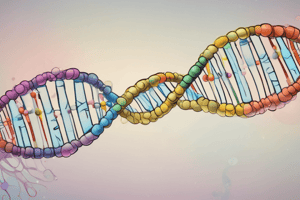Podcast
Questions and Answers
Briefly describe the process of DNA replication and explain the role of helicase, DNA polymerase, and ligase.
Briefly describe the process of DNA replication and explain the role of helicase, DNA polymerase, and ligase.
DNA replication is the process by which a double-stranded DNA molecule is copied to produce two identical DNA molecules. Helicase unwinds the DNA helix, DNA polymerase adds new nucleotides to create the new strand, and ligase joins Okazaki fragments on the lagging strand.
What is an Okazaki fragment?
What is an Okazaki fragment?
Okazaki fragments are short sequences of DNA nucleotides synthesized discontinuously and later linked together by DNA ligase.
When and why must DNA replicate?
When and why must DNA replicate?
DNA must replicate whenever a cell divides to ensure each daughter cell contains the same genetic information as the parent cell.
What are the characteristics that all prokaryotes share?
What are the characteristics that all prokaryotes share?
Describe binary fission in bacteria.
Describe binary fission in bacteria.
What characteristics do all viruses share?
What characteristics do all viruses share?
What are the various classes of viral genomes?
What are the various classes of viral genomes?
List several viral illnesses in humans.
List several viral illnesses in humans.
List several bacterial illnesses in humans.
List several bacterial illnesses in humans.
How is a medical treatment for a bacterial infection different from medical treatment for a viral infection?
How is a medical treatment for a bacterial infection different from medical treatment for a viral infection?
Describe a basic virus 'life' cycle.
Describe a basic virus 'life' cycle.
Explain the difference between lytic and lysogenic bacteriophages.
Explain the difference between lytic and lysogenic bacteriophages.
Describe the structure of a bacteriophage.
Describe the structure of a bacteriophage.
Explain how viruses can be associated with cancer (Example: HPV).
Explain how viruses can be associated with cancer (Example: HPV).
List viruses that appear to cause certain human cancers.
List viruses that appear to cause certain human cancers.
Flashcards are hidden until you start studying
Study Notes
DNA Replication Process
- DNA replication produces two identical DNA molecules from a double-stranded DNA molecule.
- Essential for cell division so each daughter cell inherits the same genetic information.
Key Enzymes in DNA Replication
- Helicase: Unwinds the DNA helix to separate the two strands.
- DNA Polymerase: Adds new nucleotides to form a complementary strand.
- Ligase: Joins Okazaki fragments on the lagging strand, acting as a "spot welder."
Leading vs. Lagging Strands
- Leading Strand: Synthesis occurs continuously.
- Lagging Strand: Synthesized in short segments called Okazaki fragments, which are later joined by ligase.
Antiparalleism in DNA
- Antiparalleism refers to the orientation of the two DNA strands running in opposite directions.
- Continuous synthesis of both strands is hindered due to the need for backtracking while building the lagging strand.
Okazaki Fragments
- Short sequences synthesized discontinuously during DNA replication on the lagging strand.
- Later linked together by DNA ligase.
Importance of DNA Replication
- Occurs prior to cell division to ensure each daughter cell has the same DNA as the parent cell.
Characteristics of Prokaryotes
- Unicellular organisms with no internal compartments or membrane-bound organelles.
- DNA is circular and not associated with proteins (naked DNA).
Binary Fission in Bacteria
- Asexual reproduction method where the bacterial chromosome replicates and divides.
- Offspring are genetically identical to the parent.
Common Characteristics of Viruses
- Acellular: lack cytoplasm and cellular organelles.
- Cannot metabolize independently; rely on host cells for replication.
- Typically contain either DNA or RNA, but not both.
Classes of Viral Genomes
- Viral genomes can be composed of DNA or RNA and can exist in linear or circular forms.
Viral Illnesses in Humans
- Examples include hepatitis, measles, polio, chicken pox, and influenza.
Bacterial Illnesses in Humans
- Notable infections include yellow fever and bubonic plague.
Treatment Differences
- Bacterial infections may be treated with antibiotics or vaccines, whereas viral infections often require antiviral therapies.
Virus Life Cycle
- Basic stages include entry into a host cell, assimilation of host cellular machinery, and self-assembly of new virus particles.
Lytic vs. Lysogenic Bacteriophages
- Lytic: Destroy host cell to release new virus particles after replication.
- Lysogenic: Integrate viral DNA into the host's DNA and replicate along with the host's cellular division.
Structure of a Bacteriophage
- Comprises a 20-sided capsid head containing DNA, and a protein tail that attaches to the bacterial host to inject viral DNA.
Viruses and Cancer Association
- Certain viruses can integrate their DNA into host cells, altering genetic function and potentially leading to cancer.
- HPV is a notable example, combining its DNA with the host's DNA, disrupting normal cell processes.
Viruses Linked to Human Cancers
- Examples include Hepatitis B (liver cancer), Epstein-Barr virus (lymphoma), Papillomaviruses (cervical cancer), and HTLV-1 retrovirus (leukemia).
Studying That Suits You
Use AI to generate personalized quizzes and flashcards to suit your learning preferences.




